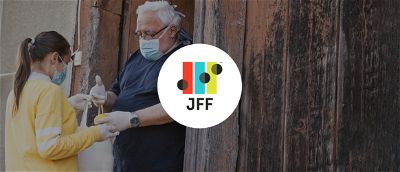
National Service: A Lifeline for Disconnected Young People
May 26, 2020
At a Glance
Enlisting the growing number of disconnected young people to create a vibrant national service corps would solve multiple pandemic-related problems at once. One million opportunity youth could help the country—and themselves—get back on track.
Even in the steadily growing economy of the past 10 years, millions of teenagers and young adults became cut off from school and work and struggled to support themselves. Now, with the abrupt interruption of schooling and the economic devastation caused by the COVID-19 pandemic, there is sure to be a sharp—and potentially exponential—rise in the number of disconnected young people.
But a wonderfully big idea has emerged, and it could make a real difference—a new, expanded version of a national service corps, made up of 18-to-26-year-olds. Youth advocates have called for starting with 500,000 corps members and expanding that number to at least 1 million by 2022.
There is much that’s promising here—and enlisting disconnected youth to fill the ranks would have a magnificent multiplier effect.
Young people of color, and those from low-income households, face the highest risk of youth disconnection and its long-lasting impacts. We must act now to support these vulnerable teens and young adults—sometimes called “opportunity youth”—who are a significant proportion of the rising workforce and will be vital to our long-term economic recovery.
We must act now to support these vulnerable teens and young adults.
Similar to AmeriCorps, but much larger, a new national youth service corps could fan out across the country to augment the efforts of frontline workers responding to the pandemic. Participation would help young adults who have been out of school and work to regain the momentum that comes with having a sense of purpose, hope, and a much-needed paycheck.
The multiplier effect would arise from mobilizing older Corps members who were once disconnected themselves to reach out to younger opportunity youth and persuade them to join.
A critical part of the program would be providing education, training, and on-the-job experience. Corps members would learn and practice vital new skills they could apply toward future school, training, and work. Professional development could include using real-time labor market information to forecast which jobs are growing so that graduates could focus on high-demand industries in their communities. Ideally, to ensure that the program is inclusive, each Corps member would receive compensation that includes a living wage and benefits, taking into consideration the need for food, child care, housing, transportation and other basic needs.
Design National Youth Service for the COVID Era
AmeriCorps programs provide some of the basic design principles for national youth service. But more invention will be required to offer programs that directly address the needs of young people in the COVID era. Here are our initial ideas for how to turn around the lives of 1 million opportunity youth while helping to turn around our economy and our society at the same time.
High School Reengagement Crews
Reengagement crews could begin an all-out effort this summer to reconnect with the many young people who left high school this spring because they had to take on added family responsibilities or lost interest when classes went online. Armed with data from school districts, the latest social media apps, and good old-fashioned footwork (where safe), corps members would first focus on locating students and then begin to connect them to the supports they need to get back on track.
Such outreach has succeeded before, and these crews can learn from past efforts in communities as varied as Boston and the Pharr, San Juan, and Alamo region of South Texas.
Reconnection services might include tutoring and mentoring (potentially provided by older corps members), alternative education, job training, and trauma-informed counseling. All could be offered virtually, in person, or in some combination.
New tech-enabled ideas might include using data analytics to target “come back to school” ads on social media and creating a Tinder-like reengagement app for a quick view of community-based organizations and education offerings. Swipe right or left to indicate opportunities to learn more about (or not).
Why the Number of Opportunity Youth Will Grow Due to COVID-19
More youth are leaving high school without graduating
The coronavirus has been loosening the ties between young people and their schools, especially in high-poverty communities where the digital divide is greatest. In large urban areas, as many as half of all students are not showing up for virtual classes. Meanwhile, rural areas are scrambling for the hardware and Wi-Fi hot spots needed to enable online learning. Many students are in danger of drifting away, which is exactly what happened in New Orleans when school was disrupted for months after Hurricane Katrina.
More young people who graduate from high school have uncertain plans
High school graduates and their parents have reported feeling overwhelmed and uncertain about the future and deciding what to do in the face of college campus shutdowns, high unemployment, and a faltering economy. This is especially true for the half of graduates whose plans for life after high school were tenuous prior to COVID-19. They have the greatest need for college and career advising, lack stable funding, and now are more likely than ever to get lost in the transitions between high school, postsecondary education, and careers.
More young adults are unemployed and uncredentialled
Before COVID 19, nearly half of all U.S. workers ages 16 to 24 worked in industry sectors that have since been particularly hard hit by the pandemic, such as hospitality, retail, and child care. For many young people, these jobs represent not only much-needed income to meet daily expenses but also a way to pay for education and training. As the Great Recession revealed, even as the U.S. economy starts to recover, it could take a decade or more for low-income young adults to begin to benefit.
College-Bridge Crews
Corps members who are (or recently have been) in college could be trained and deployed as peer advisors or tutors to current high school students or recent graduates who are uncertain about whether to enroll in college.
Drawing from the best of existing programs, and using virtual platforms as needed, college-bridge crews could partner with postsecondary institutions to repair their fraying ties with high school students. Crews could also partner with virtual college tour companies, such as YouVisit, to expand the types of “tours” available to include more community colleges and apprenticeships. Nudging apps, such as Persistence Plus, could help meet deadlines.
The goal would be to help young people overcome the new hurdles that have arisen as a result of the pandemic and take the usual steps required for making a smooth transition to postsecondary education. These include securing financial aid, preparing for placement tests, and selecting the right courses. Whenever possible, the crew would team up with college support staff and remedial education specialists to offer such assistance.
Economic Relief and Recovery Crews
In the midst of the ongoing pandemic, youth service crews could also supplement workers on the front lines of our nation’s COVID response—in health care, public health, community organizations, manufacturing, and other areas (with appropriate social distancing, of course).
Youth service crews could also supplement workers on the front lines of our nation’s COVID response.
Focusing on low-income communities and communities of color would help suppress the virus and strengthen the economy in areas that have disproportionately become COVID hotspots.
Crew members who know these communities could be particularly responsive to emerging needs. Work might include contract tracing, delivering food to isolated residents, and assisting frontline health care workers. They could also help public health officials pass on messages about how to stay as safe as possible—even when going to work every day—in a way that is inclusive and community-centered.
‘Nothing About Us Without Us’
These ideas illustrate some of the many ways a national youth service corps could mobilize our currently disconnected young people to make a difference—for their communities and their own futures. Incentive dollars, from a combination of public and private funds, could go a long way to enabling the kind of invention sessions, prototyping, and hackathons needed to flesh out a full design.
Any plans must include the voices of the youth themselves, who helped to lead a movement over the past decade with an essential message speaking to their vast potential: “Nothing about us without us.”
Related Content

Covid-19 Legislative Summary
JFF has developed a summary of the three stimulus packages that have been passed by Congress in response to the COVID-19 pandemic. The summary focuses on the emergency needs of workers, students, small businesses, education…

States Look to Strengthen College in High School Programs Amid COVID-19
In a rapidly reimagined virtual workshop, officials from five states work on ways to strengthen college in high school programs, which will have an important role to play in a post-COVID-19 world.
